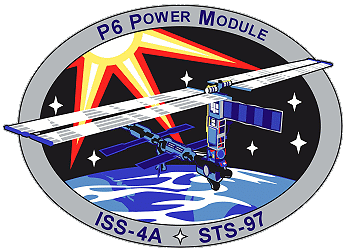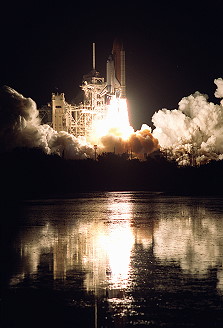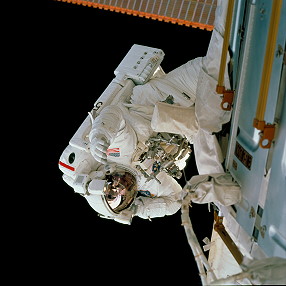Human Orbital Spaceflights
![]()
International Flight No. 218STS-97Endeavour (15)101st Space Shuttle missionUSA |
 |
 |
![]()
Launch, orbit and landing data
walkout photo |
 |
||||||||||||||||||||||||||||||||
alternative crew photo |
Crew
| No. | Surname | Given names | Position | Flight No. | Duration | Orbits | |
| 1 | Jett | Brent Ward, Jr. | CDR, IV | 3 | 10d 19h 57m 22s | 170 | |
| 2 | Bloomfield | Michael John "Bloomer" | PLT, RMS-2 | 2 | 10d 19h 57m 22s | 170 | |
| 3 | Tanner | Joseph Richard "Joe" | MS-1, EV-1 | 3 | 10d 19h 57m 22s | 170 | |
| 4 | Garneau | Joseph Jean-Pierre Marc | MS-2, RMS, IV, FE | 3 | 10d 19h 57m 22s | 170 | |
| 5 | Noriega | Carlos Ismael | MS-3, EV-2 | 2 | 10d 19h 57m 22s | 170 |
Crew seating arrangement
|
 |
|
||||||||||||||||||||||||
Hardware
| Orbiter : | OV-105 (15.) |
| SSME (1 / 2 / 3): | 2054-2A (2.) / 2043-2A (5.) / 2049-2A (4.) |
| SRB: | BI-103 / RSRM 72 |
| ET: | ET-105 (SLWT-10) |
| OMS Pod: | Left Pod 04 (22.) / Right Pod 01 (29.) |
| FWD RCS Pod: | FRC 5 (15.) |
| RMS: | 303 (13.) |
| EMU: | EMU No. 3011 (PLSS No. 1011) / EMU No. 3013 (PLSS No. 1013) / EMU No. 3016 (PLSS No. 1016) |
Flight
|
Launch from Cape Canaveral (KSC) and
landing on Cape Canaveral (KSC), Runway 15. During the sixth mission to the ISS, the primary objective was completed, which was to deliver and connect the first set of U.S.-provided solar arrays to the International Space Station. The astronauts completed three spacewalks, during which they prepared a docking port for arrival of the Destiny Laboratory Module, installed Floating Potential Probes to measure electrical potential surrounding the station, installed a camera cable outside the Unity Module, and transferred supplies, equipment and refuse between Endeavour and the station. Flight Day 2 was a day of preparation for Endeavour's crew as the astronauts activated and checked out the Shuttle's robotic arm using it to conduct a survey of the cargo latched into the payload bay; check out the Space Vision System that will provide Marc Garneau with visual cues as he unberths the P6 truss from the payload bay on Flight Day 3; inspect the space suits that will be worn by Astronauts Joseph Tanner and Carlos Noriega on the spacewalks; and begin activating wireless instrumentation systems that provide temperature data on the cargo mounted in Endeavour's payload bay. Also, the ODS centerline camera was installed with no misalignment noted. Endeavour's rendezvous with the International Space Station began with its precisely timed launch from the Kennedy Space Center in Florida. The primary pre-rendezvous activities included a check-out of the orbiter's remote manipulator system, or robot arm, (RMS), the extravehicular mobility units (EMUs), the Ku-band antenna, the orbiter docking system (ODS), and the ground command system. Final rendezvous operations began about three hours prior to Endeavour's docking with the ISS. Endeavour approached the ISS from below, in what is referred to as a plus-R bar approach, to minimize the effects of jet thruster firings on the station and its solar arrays. About 40 minutes prior to the terminal initiation burn (Ti burn) when Endeavour moved within 135,000 feet (41,148 km) of the station, the Shuttle's rendezvous radar system was activated to provide supplemental navigation information. Prior to initiating the Ti burn, the crew powered on the ODS and activated Endeavour's docking lights. A series of course correction burns brought Endeavour to a point almost directly below and behind the International Space Station, at which point Commander Brent Jett initiated the manual portion of his approach to the ISS. Endeavour intercepted the R-bar at a distance of about 600 feet (182.9 meters) below the station. Brent Jett slowly moved Endeavour to a point about 500 feet (152.4 meters) below the station before performing a 180-degree yaw maneuver to position Endeavour in a "tail forward" attitude for the final approach and docking. As Brent Jett gently moved Endeavour toward the station, the Shuttle held stationkeep at distances of 170 feet (51.8 meters) and 30 feet (9.14 meters) before initiating the final approach and docking. Solar arrays on the Zarya and Zvezda modules were feathered (or positioned) and locked during the 170-foot (51.8 meters) stationkeeping phase. Feathering was initiated by a command to reposition and hold each beta (and alpha) joint at a predetermined angle, which will limit the induced loads. Endeavour docked with Pressurized Mating Adapter (PMA) 3 located on the nadir port of the Unity module on December 02, 2000. This new docking port was installed during the STS-92 mission in October 2000. At initial contact and capture, the ISS automatically switched to free drift, and Endeavour went to free drift to avoid imposing excessive loads on the orbiter docking system (ODS). After capture, light-emitting diodes (LEDs) on PMA-3 blinked confirming the ISS was in free drift. The crew was able to see the red indicators through the overhead window on Endeavour's aft flight deck and verify that the ISS was in the free-drift mode before beginning the automatic rigidization and retraction process and closure of the capture latches between the two docking hatches. Once a "hard dock" was confirmed, the ODS was deactivated, Zvezda and Zarya solar arrays were resume sun tracking, and the Endeavour-ISS complex was maneuvered to the mated attitude. After the orbiter docked with the ISS, the crew entered PMA-3 to install ground straps, and perform a pressure leak check and center disk removal to prepare for their later entry into the Unity module of the ISS for supply transfer. After Endeavour docked to the International Space Station, Marc Garneau used the Shuttle's robot arm to lift the P6 structure out of the payload bay where it remained attached overnight. Prior to the start of the first spacewalk, he used the arm to move the 35,000-pound (15,876 kg) assembly to the "low hover" position adjacent to Endeavour's payload bay. The first EVA by Joseph Tanner and Carlos Noriega was performed on December 03, 2000 (7h 33m). They performed preparation work for the mount of the energy module and checked the docking to P6/Z1. Once the P6 was in its low hover position, the EVA crew exited Endeavour's air lock and began assembling the tools and hardware they used during the spacewalk. Joseph Tanner and Carlos Noriega took positions on the forward and aft sides of the Z1 truss, respectively, to provide robot arm operator Marc Garneau with visual cues as he unberthed the P6 structure. Marc Garneau's primary cues came from the Space Vision System that provided him with a closed-circuit television view of targets located on the P6 and the ISS, but Joseph Tanner and Carlos Noriega provided verbal confirmation and additional visual cues throughout the unberthing process. Once Marc Garneau moved the P6 within its capture envelope, Joseph Tanner and Carlos Noriega verified the ready-to-latch position and activated the capture latches on the Z1 truss, initiating a coarse alignment between the P6 and Z1 truss. Carlos Noriega then drove the capture latch assembly to bring the P6 into fine alignment. After the structure was secured in place - by 127 turns of the Capture Latch Assembly (CLA) - Joseph Tanner and Carlos Noriega began securing bolts on each of the four corners of the P6 before releasing the capture latch to allow loads to be carried through the primary bolts. At that point, Marc Garneau released the robot arm's grip on the P6 structure and maneuvered it into position to allowed Carlos Noriega to attach an articulating portable foot restraint. At this point in the spacewalk, Pilot Michael Bloomfield assumed responsibility for operating the robot arm using it to maneuver Carlos Noriega as he connected the nine power, command and data umbilicals from Z1 to the forward face of the P6 that will provide power to the Orbital Replacement Units in anticipation of the deployment of the large solar arrays. Marc Garneau, the back-up EVA crew member, then turned his full attention to acting as the on-board choreographer for the remainder of the EVA's. As Carlos Noriega connected the umbilicals, Joseph Tanner set to work releasing first the starboard and then the port Solar Array Blanket Boxes (SABB) by releasing a series of 5/8" bolts - two on the nadir and six on the zenith ends of each SABB. Carlos Noriega's next task was to release the starboard Solar Array Wing (SAW) Beta Gimbal launch restraint (BGA) by releasing a pair of retention bolts and allowing the BGA to swing outward and upward or downward into its deployed position. Following the release of the starboard SAW BGA, Joseph Tanner performed a similar function on the port side of the structure. Both Joseph Tanner and Carlos Noriega then began deploying the SABBs by releasing a pip pin on the mast canister and then rotating the boxes 90 degrees from their launch position to their deployable position. Once in the deploy position, a locking arm holds each box in position. The spacewalkers then released three bolts that hold the mast tip fitting releasing it from the top of the mast canister. At that point, Brent Jett commanded the mast to deploy, beginning the unfolding of the large solar arrays. One of the solar arrays failed to unfold in a first attempt. A second attempt was needed to unfold the solar array properly. The second EVA by Joseph Tanner and Carlos Noriega occurred on December 05, 2000 (6h 37m). The astronauts connected electric power cables between the new P6/Z1 and the module Unity. The port wing successfully spread after the second spacewalk. The second spacewalk was designed to reconfigure electrical connections so that power from the newly-installed P6 solar arrays can be distributed to the U.S. elements of the ISS. Carlos Noriega worked on the port side of the truss structure reconfiguring cables and moving them from one connector to the other to support the transfer of power and then removing a thermal shroud from a DC to DC Conversion Unit (DDCU). Joseph Tanner removed a similar shroud from a baseband signal processor (BSP) and prepared to relocate the S-Band Antenna Subassembly (SASA) from its location on the Z1 truss where it was temporarily stowed by the STS-92 crew in October 2000. The thermal shrouds were removed to allow the DDCU and BSP to dissipate heat as they began operating off of power generated by the P6 arrays. One of the major elements of this second EVA was the relocation of the SASA as Joseph Tanner and Carlos Noriega moved it from a temporary stowage location on the starboard side of the Z1 truss to its new location on the top of the P6 array. Joseph Tanner removed the power connections that provide maintenance power to the Z1 truss as he unbolted the SASA. Michael Bloomfield maneuvered the arm to Carlos Noriega's location tethered to the Integrated Equipment Assembly (IEA) where, in a series of "leap frog" like exchanges, Joseph Tanner and Carlos Noriega did alternative possession of the SASA until the antenna assembly was installed in its operating position on the IEA. They removed its thermal shroud and gimbal locks, readying the SASA for operation. Joseph Tanner then descended from the truss assembly to connect thermal system umbilicals between the Z1 and P6 truss assemblies, while Carlos Noriega resumed work mating umbilical cables to the Z1 patch panel. The remaining EVA tasks were designed to pave the way for the arrival of the U.S. Laboratory Destiny early 2001. Joseph Tanner mounted the robotic arm to mate a prerouted cable for the centerline berthing camera to the early communications system antenna to provide the STS-98 crew with camera views to aid them in attaching the large lab module. Joseph Tanner and Carlos Noriega then removed umbilicals from Pressurized Mating Adapter-2 (PMA-2) connecting them to a dummy panel located on that docking port preparing it for relocation to the aft end of the Destiny module during the STS-98 mission. The third and final EVA was conducted by Joseph Tanner and Carlos Noriega on December 07, 2000 (5h 10m). First, they had to repair a solar array wing. Later they installed Floating Potential Probes to measure electrical potential surrounding the station, installed a camera cable outside the Unity Module. After that the crew of the Endeavour turned over to the ISS and its current resident crew (December 08, 2000). Until then the shuttle and the station had kept one hatch closed to maintain respective atmospheric pressures, allowing the shuttle crew to conduct their spacewalks and mission goals. After a welcome ceremony and briefing, the eight spacefarers conducted structural tests of the station and its solar arrays, transferred equipment, supplies and refuse back and forth between the spacecraft, and checked out the television camera cable installed by Joseph Tanner and Carlos Noriega for the upcoming mission. On December 09, 2000 the two crews completed final transfers of supplies to the station and other items being returned to Earth. The Endeavour crew bade farewell to the first expedition at 15:51 UTC and closed the hatches between the spacecraft. Before Endeavour undocked and departed, ground personnel updated the ISS vector and mass data. These data included attitude departure maneuver data, attitude hold data, post-departure mass properties, and post-departure attitude maneuver data. A navigation platform alignment was performed. Zvezda and Zarya solar arrays were commanded to stop sun tracking and was feathered to the edge-on position. In preparation for undocking from the ISS, the STS-97 crew once again powered-up the orbiter docking system, turned on the Shuttle's docking lights, terminated all OIU operations, and enabled the Shuttle's navigational aids. Following its undocking from the ISS, Pilot Michael Bloomfield slowly backed Endeavour away from the ISS at the rate of about 1/10th of a foot-per-second (3 centimeters per second) before beginning a flyaround of ISS. Endeavour moved to a point about 450 feet (137.2 meters) below the station before beginning a tail-forward circuit of the station, arriving once again at a position approximately 600 feet (182.9 meters) below the ISS. At that point, Michael Bloomfield performed a final separation burn to move Endeavour away from the station. Once Endeavour was about 30 feet (9.14 meters) away from the station, the Expedition One crew activated the station's attitude control systems. The Zvezda module then maneuvered station to is normal orientation for orbital operations, the solar arrays were commanded to resume sun tracking, and the station docking system and lights were deactivated. |
EVA data
| Name | Start | End | Duration | Mission | Airlock | Suit | |
| EVA | Tanner, Joseph | 03.12.2000, 18:35 UTC | 04.12.2000, 02:08 UTC | 7h 33m | STS-97 | Endeavour - ISS | EMU No. 3011 |
| EVA | Noriega, Carlos | 03.12.2000, 18:35 UTC | 04.12.2000, 02:08 UTC | 7h 33m | STS-97 | Endeavour - ISS | EMU No. 3013 |
| EVA | Noriega, Carlos | 05.12.2000, 17:21 UTC | 05.12.2000, 23:58 UTC | 6h 37m | STS-97 | Endeavour - ISS | EMU No. 3013 |
| EVA | Tanner, Joseph | 05.12.2000, 17:21 UTC | 05.12.2000, 23:58 UTC | 6h 37m | STS-97 | Endeavour - ISS | EMU No. 3011 |
| EVA | Tanner, Joseph | 07.12.2000, 16:13 UTC | 07.12.2000, 21:23 UTC | 5h 10m | STS-97 | Endeavour - ISS | EMU No. 3011 |
| EVA | Noriega, Carlos | 07.12.2000, 16:13 UTC | 07.12.2000, 21:23 UTC | 5h 10m | STS-97 | Endeavour - ISS | EMU No. 3013 |
Photos / Graphics
 |
 |
 |
 |
 |
 |
 |
 |
 |
 |
 |
 |
 |
 |
more EVA photos |
|
| © |  |
Last update on March 27, 2020.  |
 |